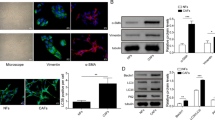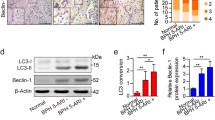Abstract
Purpose
Benign prostatic hyperplasia (BPH) is one of the most prevalent diseases affecting aging males. However, approximately, 8% of the BPH patients under 50-year-old experience remarkably early progression, for reasons that remain elusive. Among the various factors implicated in promoting BPH advancement, the activation of fibroblasts and autophagy hold particular importance. Our research endeavors to explore the mechanisms behind the accelerated progression in these patients.
Methods
Immunohistochemistry and immunofluorescence were performed to detect the expression levels of LC3, p62, PDE5, and α-SMA in diverse BPH tissues and prostate stromal cells. The autophagy activator rapamycin, the autophagy suppressor chloroquine, and siRNA transfection were used to identify the impact of autophagy on fibroblast activation.
Results
Prostatic stromal fibroblasts in early progressive BPH tissues displayed activation of autophagy with an upregulation of LC3 and a concurrent downregulation of p62. After starvation or rapamycin treatment to a heightened level of autophagy, fibroblasts exhibited activation. Conversely, chloroquine treatment and ATG-7-knockdown effectively suppressed the level of autophagy and fibroblast activation. High expression of PDE5 was found in early progressive BPH stromal cells. The administration of PDE5 inhibitors (PDE5Is) hindered fibroblast activation through suppressing autophagy by inhibiting the ERK signaling pathway.
Conclusion
Our findings suggest that autophagy plays a pivotal role in promoting BPH progression through fibroblast activation, while PDE5Is effectively suppress autophagy and fibroblast activation via the ERK signaling pathway. Nevertheless, further investigations are warranted to comprehensively elucidate the role of autophagy in BPH progression.




Similar content being viewed by others
Data availability
Derived data supporting the findings of this study are available from the corresponding author YN Niu on request.
References
Welén K, Damber J-E (2022) Androgens, aging, and prostate health. Rev Endocr Metab Disord 23(6):1221–1231
Brousil P et al (2015) PDE-5 Inhibitors for BPH-Associated LUTS. Curr Drug Targets 16(11):1180–1186
Garg M et al (2013) Selective estrogen receptor modulators for BPH: new factors on the ground. Prostate Cancer Prostatic Dis 16(3):226–232
Liu Z et al (2022) Upregulation of mir-1199-5p is associated with reduced type 2 5-α reductase expression in benign prostatic hyperplasia. BMC Urol 22(1):172
Sheng J et al (2018) M2 macrophage-mediated interleukin-4 signalling induces myofibroblast phenotype during the progression of benign prostatic hyperplasia. Cell Death Dis 9(7):755
Notara M, Ahmed A (2012) Benign prostate hyperplasia and stem cells: a new therapeutic opportunity. Cell Biol Toxicol 28(6):435–442
Wang L et al (2017) Aberrant Transforming Growth Factor-β Activation Recruits Mesenchymal Stem Cells During Prostatic Hyperplasia. Stem Cells Transl Med 6(2):394–404
Gravina GL et al (2013) Phenotypic characterization of human prostatic stromal cells in primary cultures derived from human tissue samples. Int J Oncol 42(6):2116–2122
Rodriguez-Nieves JA, Macoska JA (2013) Prostatic fibrosis, lower urinary tract symptoms, and BPH. Nat Rev Urol 10(9):546–550
Miceli C et al (2023) Autophagy-related proteins: Potential diagnostic and prognostic biomarkers of aging-related diseases. Ageing Res Rev 89:101967
Ke Z-B et al (2019) Identification of key genes and pathways in benign prostatic hyperplasia. J Cell Physiol 234(11):19942–19950
Cai J-L, Yao W-M, Na Y-Q (2017) Correlation between Cholinergic Innervation, Autophagy, and Etiopathology of Benign Prostatic Hyperplasia. Chin Med J 130(16):1953–1960
Zhang Y et al (2020) PGC-1α regulates autophagy to promote fibroblast activation and tissue fibrosis. Ann Rheum Dis 79(9):1227–1233
Qiang L et al (2021) Keratinocyte autophagy enables the activation of keratinocytes and fibroblastsand facilitates wound healing. Autophagy 17(9):2128–2143
Mónica FZ, De Nucci G (2019) Tadalafil for the treatment of benign prostatic hyperplasia. Expert Opin Pharmacother 20(8):929–937
Plochocki A, King B (2022) Medical Treatment of Benign Prostatic Hyperplasia. Urol Clinics N Am 49(2):231–238
Karabiyik C et al (2021) Glucose starvation induces autophagy via ULK1-mediated activation of PIKfyve in an AMPK-dependent manner. Development Cell 56:13
Le TV et al (2023) Autophagy Inhibitor Chloroquine Downmodulates Hepatic Stellate Cell Activation and Liver Damage in Bile-Duct-Ligated Mice. Cells 12:7
Qiao L et al (2021) The E2F1/USP11 positive feedback loop promotes hepatocellular carcinoma metastasis and inhibits autophagy by activating ERK/mTOR pathway. Cancer Lett 514:63–78
Ashraf R, Kumar S (2022) Mfn2-mediated mitochondrial fusion promotes autophagy and suppresses ovarian cancer progression by reducing ROS through AMPK/mTOR/ERK signaling. Cellular and Molecular Life Sciences : CMLS 79(11):573
Marchand B et al (2023) Gemcitabine promotes autophagy and lysosomal function through ERK- and TFEB-dependent mechanisms. Cell Death Discovery 9(1):45
Zhang N et al (2015) Hypoxia-induced autophagy promotes human prostate stromal cells survival and ER-stress. Biochem Biophys Res Commun 464(4):1107–1112
Wang Y-B et al (2022) Causal relationship between obesity, lifestyle factors and risk of benign prostatic hyperplasia: a univariable and multivariable Mendelian randomization study. J Transl Med 20(1):495
Jiang C-Y et al (2018) Deregulation of ATG9A by impaired AR signaling induces autophagy in prostate stromal fibroblasts and promotes BPH progression. Cell Death Dis 9(4):431
Zhou L et al. (2023) Decoding ceRNA regulatory network and autophagy-related genes in benign prostatic hyperplasia. Internat J Biol Macromol 225:997–1009
Zhang N et al (2018) MicroRNA expression profiles in benign prostatic hyperplasia. Mol Med Rep 17(3):3853–3858
Wang C (2010) Phosphodiesterase-5 inhibitors and benign prostatic hyperplasia. Curr Opin Urol 20(1):49–54
Zhang W et al (2015) Upregulation of Phosphodiesterase type 5 in the Hyperplastic Prostate. Sci Rep 5:17888
Liu H et al (2021) Danshensu alleviates bleomycin-induced pulmonary fibrosis by inhibiting lung fibroblast-to-myofibroblast transition via the MEK/ERK signaling pathway. Bioengineered 12(1):3113–3124
Acknowledgements
This work was supported by the National Natural Science Foundation of China (grant number:82000718 and 82170783) and Youth Talent Cultivation Program of Beijing (grant number: QML20230904).
Author information
Authors and Affiliations
Contributions
SJ: project development, manuscript writing; ZLL: project development, manuscript writing; XP: data collection; MF: project development; GZ: project development; JXL: manuscript writing and editing; YNN: project development, manuscript writing and editing.
Corresponding authors
Ethics declarations
Conflict of interests
The authors declare that they have no conflict of interest.
Ethical approval
Ethics Committee of Beijing Tsinghua Changgung Hospital approved this study (20062-0-01), and written informed consent was obtained from each participating patient.
Informed consent
Informed consent was obtained from all the individuals participants included in this study.
Additional information
Publisher's Note
Springer Nature remains neutral with regard to jurisdictional claims in published maps and institutional affiliations.
Supplementary Information
Below is the link to the electronic supplementary material.
Rights and permissions
Springer Nature or its licensor (e.g. a society or other partner) holds exclusive rights to this article under a publishing agreement with the author(s) or other rightsholder(s); author self-archiving of the accepted manuscript version of this article is solely governed by the terms of such publishing agreement and applicable law.
About this article
Cite this article
Jin, S., Liu, Z., Xiang, P. et al. Activation of the cGMP/PKG/ERK signaling pathway associated with PDE5Is inhibits fibroblast activation by downregulating autophagy in early progressive benign prostatic hyperplasia. World J Urol 42, 333 (2024). https://doi.org/10.1007/s00345-024-04956-9
Received:
Accepted:
Published:
DOI: https://doi.org/10.1007/s00345-024-04956-9




